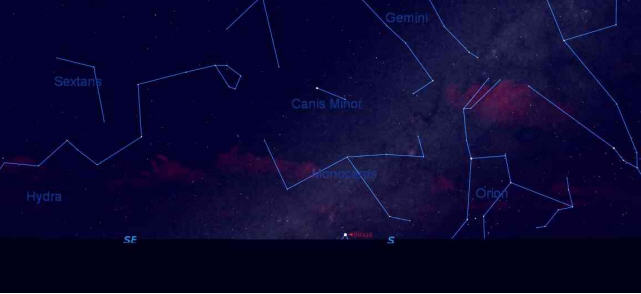But Göbekli Tepe may also be the world's oldest science building.
Giulio Magli of the Polytechnic University of Milan hypothesizes it may have been built due to the “birth” of a “new” star; the brightest star and fourth brightest object of the sky, what we call Sirius (Greek for "glowing").
Sirius, which we also call the 'dog star' due to its location in the constellation Canis Major, was obviously not born 12,000 years ago, but Hipparchus would not discover the phenomenon of "precession" until 200 BC, when he compared the equinoxes in his time with older charts and made the connection. Precession at the latitude of Göbekli Tepe would have sent Sirius under the viewing horizon of those in ancient Turkey around 15,000 BC, where it remained unseen again until around 9,300 B.C. To those residents it was a new star appearing for the first time.

Gobekli Tepe megalithic enclosures, view from the south (image in the public domain). Credit: arXiv:1307.8397
Anil Ananthaswamy writing in New Scientist has an interesting take as well. The Neolithic revolution hypothesis says that the invention of agriculture led to fixed human settlements and then art and religion other hallmarks of civilization - but there is no evidence of agriculture near the temple, which suggest that religion came first.
There's no doubt that religion and understanding motions of the stars have been mixed throughout history (and still are, as the enduring popularity of astrology can attest) but if it were strictly religious, why would it not have been duplicated more often? The structures that bear the most resemblance to Göbekli Tepe, on the Spanish island of Menorca, were built 8,000 years later.
Magli says this new star may have prompted a new religion that was not evident anywhere else. Or, as is the case of Stonehenge, it could have been a multi-purpose astronomical observatory that also became a religious site. The evidence for astronomy? Excavated rings.
"The extrapolated mean azimuths of the structures (taken as the mid-lines between the two central monoliths) are estimated as follows":
Structure D 172°
Structure C 165°
Structure B 159°
Those azimuths match the rising azimuths of Sirius:
Structure D 172° 9,100 BC
Structure C 165° 8,750 BC
Structure B 159° 8,300 BC

Gobekli Tepe showing the rising of Sirius at azimuth 172°, a few days before summer solstice, in 9,100 BC. Credit: arXiv:1307.8397
So what are the answers? No one knows - it may never be established definitively. That is the fun of trying to piece together the ancient world and how people viewed the universe. Aside from Göbekli Tepe, Sirius also still has lots of enduring mysteries we can't quite understand, despite its prominence, such as why ancient astronomers like Claudius Ptolemy said it was red. An atmospheric effect, such as due to the Earth's atmosphere as it appears on the horizon, would have been a real rookie mistake by 150 A.D. so that is unlikely.
If you want to visit Turkey and give your own hypothesis a try, duplicate this work while you can. We think the stars will be in the same place forever, just like people in the 10th millennium B.C. did, but that really isn't so. The previously mentioned astronomically-oriented sanctuaries of Menorca were built to highlight the then-bright Crux-Centaurus group in the southern sky, but those are disappearing from the sight of those 93,000 Mediterranean island inhabitants - also due to precession.
Precession will also lead to lots of fun science for astronomers to come. Polaris, the 'north star', is only such by coincidence of evolution as I write this. Vega will be our north star of the future - in about 13,000 years.
Preprint: Giulio Magli, 'Sirius and the project of the megalithic enclosures at Gobekli Tepe', arXiv:1307.8397
NOTE: Why the title? In high school, me and my friends competed in a science and math challenge against a few dozen other schools (I only placed second in physics - why is a story for another time) and for the 'College Bowl' challenge, where teams compete against each other to answer questions and solve problems, the first 'question' in our competition went "Astronomers will tell you this is no laughing matter."
I rang the buzzer immediately and answered "Sirius."





Comments